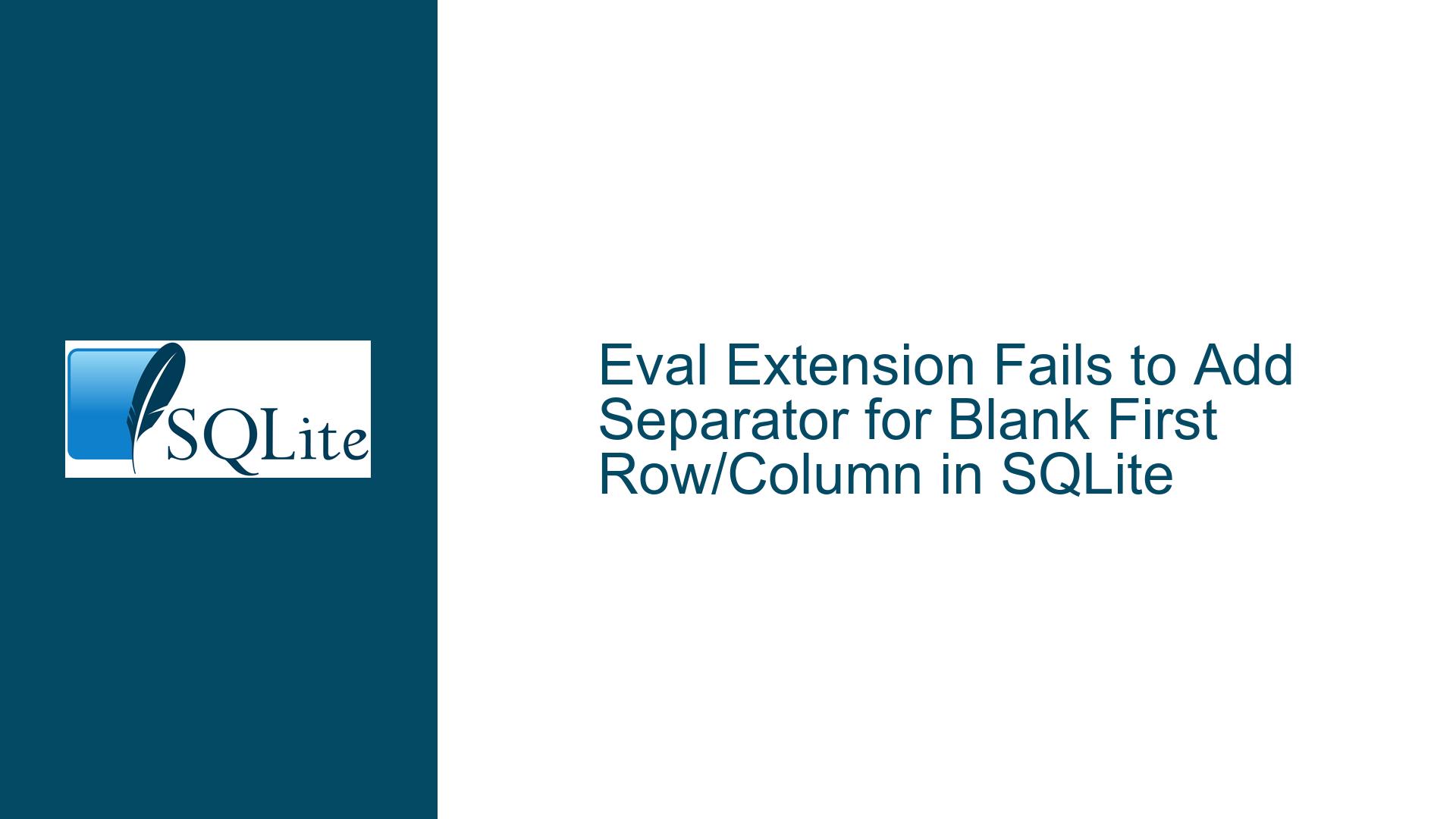Eval Extension Fails to Add Separator for Blank First Row/Column in SQLite
Issue Overview: Eval Extension’s Separator Logic Fails with Blank First Row/Column
The eval extension in SQLite is designed to facilitate the evaluation of expressions and the concatenation of results, often used in scenarios where dynamic SQL generation or row/column aggregation is required. However, a critical issue arises when the first row or column in the dataset is blank. In such cases, the eval extension fails to add the expected separator, leading to incorrect or malformed output. This behavior stems from the extension’s logic, which checks only the length of the accumulated text so far to determine whether a separator should be added. If the first row or column is blank, the accumulated text remains empty, and the separator is omitted, even though subsequent rows or columns may contain valid data.
This issue is particularly problematic in scenarios where the eval extension is used to generate CSV-like outputs, construct JSON arrays, or concatenate values with specific delimiters. The absence of a separator for blank initial rows or columns can disrupt the structure of the output, leading to parsing errors or misinterpretation of the data. For example, if the eval extension is used to concatenate values with a comma separator, a blank first row would result in the first non-blank value being incorrectly positioned, breaking the expected format.
The root of the problem lies in the extension’s failure to account for the presence of rows or columns that have not yet contributed to the accumulated text. By relying solely on the length of the accumulated text, the extension overlooks the fact that a blank row or column should still trigger the addition of a separator to maintain the integrity of the output structure. This oversight can lead to subtle bugs that are difficult to diagnose, especially in complex queries where the presence of blank rows or columns may not be immediately apparent.
Possible Causes: Why the Eval Extension Misbehaves with Blank Initial Data
The eval extension’s behavior with blank initial rows or columns can be attributed to several underlying causes, each of which contributes to the failure to add the necessary separator. Understanding these causes is essential for diagnosing the issue and implementing an effective solution.
Insufficient Accumulated Text Length Check: The primary cause of the issue is the extension’s reliance on the length of the accumulated text to determine whether a separator should be added. When the first row or column is blank, the accumulated text remains empty, and the length check fails to trigger the addition of a separator. This logic is flawed because it does not consider the presence of rows or columns that have not yet contributed to the accumulated text. As a result, the separator is omitted, leading to incorrect output.
Lack of Row/Column Presence Tracking: The eval extension does not track whether rows or columns have been processed, regardless of whether they contain data. This lack of tracking means that the extension cannot distinguish between a blank row/column and the absence of rows/columns altogether. Consequently, the extension fails to recognize that a separator should be added even if a row or column is blank, as long as it is part of the dataset.
Inconsistent Handling of Blank Values: The extension’s handling of blank values is inconsistent with its intended functionality. While the extension is designed to concatenate values with separators, it does not account for the possibility that some values may be blank. This inconsistency leads to the omission of separators for blank rows or columns, disrupting the structure of the output.
Assumption of Non-Empty Initial Data: The extension appears to operate under the assumption that the initial row or column will always contain data. This assumption is not explicitly stated in the documentation, but it is evident from the behavior of the extension. When this assumption is violated, as in the case of a blank initial row or column, the extension fails to perform as expected.
Inadequate Error Handling: The extension does not provide adequate error handling or warnings when it encounters blank initial rows or columns. This lack of feedback makes it difficult for users to diagnose the issue, as the extension silently omits the separator without any indication of the problem.
Troubleshooting Steps, Solutions & Fixes: Addressing the Eval Extension’s Separator Issue
To resolve the issue with the eval extension’s failure to add a separator for blank initial rows or columns, several troubleshooting steps and solutions can be implemented. These steps aim to address the root causes of the problem and ensure that the extension behaves as expected, even when the initial data is blank.
Modify the Accumulated Text Length Check: The first step in addressing the issue is to modify the logic that checks the length of the accumulated text. Instead of relying solely on the length of the text, the extension should also consider whether any rows or columns have been processed, regardless of whether they contain data. This can be achieved by introducing a flag or counter that tracks the number of rows or columns processed. If the counter is greater than zero, a separator should be added, even if the accumulated text is empty.
Implement Row/Column Presence Tracking: To ensure that separators are added correctly, the extension should track the presence of rows or columns, even if they are blank. This can be done by maintaining a flag or counter that is incremented each time a row or column is processed. The presence of this flag or counter would allow the extension to determine whether a separator should be added, based on the number of rows or columns processed rather than the length of the accumulated text.
Consistent Handling of Blank Values: The extension should be modified to handle blank values consistently with its intended functionality. This means that separators should be added for blank rows or columns, just as they are for non-blank rows or columns. This can be achieved by updating the logic that determines when to add a separator, ensuring that it accounts for the presence of blank values.
Remove Assumption of Non-Empty Initial Data: The extension should be updated to remove the assumption that the initial row or column will always contain data. This can be done by modifying the logic that processes rows and columns, ensuring that it does not rely on the presence of data in the initial row or column. Instead, the extension should treat all rows and columns uniformly, adding separators as needed based on the number of rows or columns processed.
Enhance Error Handling and Feedback: To make it easier for users to diagnose issues with the eval extension, the extension should be enhanced to provide better error handling and feedback. This could include warnings or error messages when the extension encounters blank initial rows or columns, alerting users to the potential issue and providing guidance on how to address it.
Testing and Validation: After implementing the above changes, it is essential to thoroughly test and validate the updated eval extension to ensure that it behaves as expected in all scenarios. This testing should include cases where the initial row or column is blank, as well as cases where blank rows or columns appear elsewhere in the dataset. By validating the extension’s behavior in these scenarios, users can be confident that the issue has been resolved and that the extension will produce correct and consistent output.
Documentation Updates: Finally, the documentation for the eval extension should be updated to reflect the changes made and to provide clear guidance on how to use the extension correctly. This documentation should include examples of how the extension handles blank rows and columns, as well as any new flags or counters that have been introduced to track row/column presence. By providing clear and comprehensive documentation, users can avoid common pitfalls and ensure that they are using the extension effectively.
In conclusion, the issue with the eval extension’s failure to add a separator for blank initial rows or columns can be addressed through a combination of logic modifications, enhanced tracking, consistent handling of blank values, and improved error handling. By implementing these changes, the extension can be made more robust and reliable, ensuring that it produces correct and consistent output in all scenarios.






